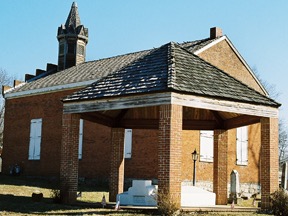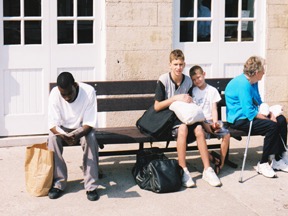Saint Cook
November 2020

It wasn’t, and that was a good thing because the chime on my radio signaled it was straight-up noon, and as the newscaster began his first story, I knew lunch was already on the table.
From different directions, Robert Shoemyer and I arrived at the table at the same time. We exchanged greetings as we sat down to the glorious task of absorbing a 15-course meal. Robert is a family friend—and my hero. He farms for a living. And like most folks who toil the whole time the sun is watching, he stays young behind his weather-beaten face that looks all the more leathery as he sits hatless across the table from me, his balding pate a pasty white above a tan line as stark as the rustline in a porcelain tub. That tan line is testament to five dozen seasons on the seat of a tractor, sowing soybeans and feeding cattle. Robert has the energy and the enthusiasm of a kid despite his eighty-some years. He owes his stamina to early rising and hard work and clean living, but mostly to his companion for 60-plus years.
Dorothy Shoemyer’s kitchen table looks like a Grandma Moses painting. Everything is on it. Everything. Her face would be on the label of the grocery-store package that says “grandma’s home cooking,” if there was such a package. Robert and I dug into a home-grown, sit-down, all-you-can-eat, family-style, “don’t stop now because there’s only a spoonful of cottage cheese left and finish up those peaches ‘cause I can’t keep up with ’em fallin’ off the trees and here, have some more fried chicken ‘cause there’s not enough room to put all this stuff back in the fridge” dinner from Dorothy Shoemyer’s kitchen table, featuring beef and gravy and new potatoes with green beans from the garden and sliced home-grown tomatoes and cucumbers from her garden, too, and corn and relish and pickled beets and bread and butter.
Robert watched me coax the last drops of chocolate syrup out of a Hershey’s squirt bottle onto a dish of vanilla ice cream. I worked the squeeze bottle like a bellows, violently expelling a few drops of syrup in a flatulent whoosh, then waited as the air wheezed back into the plastic bottle.
“Give it here,” Robert said. He grabbed the squeeze bottle and decapitated it, held it in one hand and a gallon milk jug in the other. He poured milk into the syrup bottle.
“Chocolate milk,” he explained, “and I don’t even have to dirty a glass.” Dorothy Shoemyer chuckled as she flitted like a hummingbird from stove to table to sink.
“More ice cream?” she asked.
“No, thanks,” I demurred, as I watched Robert shake his squirt bottle to make his chocolate milk. I was stuffed. It’s rare that a weary road traveler gets a home-cooked meal, especially for lunch.
Robert’s work ethic is impressive, and he’s married to Saint Cook. But that’s not why he’s my hero. Robert finds a use for everything. Or a short cut. And I knew that as soon as he finished his chocolate milk, the squeeze bottle would find the recycling bin. This lunch was a refreshing oasis in my sojourn through this big, throwaway world.
From “A Road Trip Into America’s Hidden Heart,” the perfect stocking stuffer. Visit JohnDrakeRobinson.com to learn more.
Fuzzy Fables
August 2020
Steeling Moses
May 2020

It began when I left the comfort of Route 66. Driving south into the rugged hills, I entered the land of Moses.
Most people are aware Moses never made it to the Promised Land, a detail that disturbs more than a few Texans. Technically, Moses Austin made it to Texas, but he didn’t stay. In 1821, Moses was the first person to get permission from the governor of Spanish Texas to establish an Anglo-American colony there, leading a group of 300 families from Potosi to San Antonio de Bexar. He returned to Missouri and died soon after.
His remains rest in a cemetery in the middle of downtown Potosi.
The county where he’s buried is named for the Father of Our Country. But there’s visible proof that Moses Austin is Washington County’s favorite son. And they intend to keep it that way despite the nefarious intentions of a few Texans.
Encased beneath a slab of concrete the size of a carport, Moses has resisted body snatchers so far. Lone Star historians say Texas made overtures to remove Moses from a “neglected cemetery” and repatriate him with his son, Steve, in Austin.
Potosi historians are a bit more blunt. They tattle on Texas undertaker Thurlow Weed, who they say drove a hearse to Potosi in the early 1930s and started chipping away at Moses’ tomb. The marshal and a posse of enraged citizens sent Weed tumbling back to Texas, bearing no pall. Texas historians say there was no posse and that Weed returned to Texas with a Potosi City Council resolution opposing the move.
In 1938, both parties agree, the governor of Texas made one more attempt to get Moses. Texans say the Lone Star secretary of state came to make one last plea for the body, but instead came away recommending that Moses rest in peace in Potosi. Local tales persist that the Texas official came to apologize. But regardless of the purpose of this final attempt, Potosi is the only American town to repel a Lone Star invasion.
Moses is the grandfather of Texas, not Missouri. But among his Missouri accomplishments, he donated land for this Washington County seat of government. Named for a Bolivian silver mining town, Potosi is a South American Indian word for “place of much noise,” a harbinger to the Moses grave dispute. Backwards, the word Potosi comes one letter shy of spelling isotope, appropriate for the region’s heavy metal mining. In the realm of heavy metal, Moses Austin was a rock star. He established the first reverberatory smelter west of the Mississippi. And like most rock stars, his rise and fall was mercurial. A bank failure and recession in 1819 forced him to close his lead mining business, and he turned his attention to “the Texas Venture.”
Dipping into the land of Moses’ bones, I neither saw nor smelt, nor heard heavy metal, but heavy woods stretched in every direction over these foothills to the St. Francois Mountains. Route 47 snakes down to join Highway 21, and like two old friends, they share a path for five twisting miles. The trail could be named Memory Highway, because every two miles or so, an Adopt-A-Highway sign declares “In Loving Memory of [YOUR NAME HERE].” The most intriguing dedication is “In Memory of Beef.” Well, then. Suffice it to say that this road has delivered more than one species to glory. It’s just another indication that the end is near.
Moses knew that.
But even as he believed the end justified his means, Thurlow Weed couldn’t dislodge the grandfather of Texas from his final resting place.
Visit JohnDrakeRobinson.com to find out where to purchase a copy of his latest book, Souls Along The Road.
Whistle Stop
February 2020

“I’ve learned to be patient,” said Mason, sitting next to me in his prison issue gray trousers and white T-shirt.
Earlier that morning, seven inmates had been released from three area Missouri correctional institutions. Guards gave them a lift to the depot. Two parolees awaited a train to Kansas City. Five were headed home to St. Louis.
Three prison guards milled around the depot, not particularly mindful of their charges. Why should they be? The parolees were free men as of nine o’clock that morning. The guards handed each parolee a one-way ticket and a box of belongings and waited around to ensure the parolees boarded their trains and left town.
Mason was going home after successfully completing substance abuse treatment at Fulton Diagnostic Center.
My grade school-aged grandsons sat beside me, not appearing to pay much attention. This was their first train trip. I had brought them here to experience a ride on a mode of transportation that dangles on life support. The younger grandson asked why we didn’t just drive to St. Louis. At seven years old he was too practical for nostalgia or history or anything rail related.
“You will love trains,” I predicted.
The interlude with newly-released inmates was a bonus experience.
“How long were you in?” I asked Mason.
“Five months.”
“Got work?”
“Yes sir. Post-Dispatch.”
“I applied there once. They rejected me,” I told him, thinking in some perverse logic that he’d feel better knowing that. He smiled.
Bad news. The train was running even later, an hour away. It didn’t faze the group of new parolees. “The air smells fresh,” Mason told me.
Six parolees still wore prison garb. The seventh wore brand new clothes. Joe looked crisp in his bright striped shirt, stuffed into blue jeans that shone, and Easter-white sneakers. “I’ve waited 12 and a half years for this day,” he beamed. His family would pick him up at Union Station in St. Louis.
Stacked near the tracks were six cardboard boxes and two brown paper bags, all hand-marked with last names and six-digit numbers. One box was marked “TV.” Those boxes and bags represented the entire belongings of seven men on their first day of freedom.
Mason said he didn’t want to cause any more trouble for his family. His father, a retired auto worker at the General Motors plant, would pick him up in downtown St. Louis. And soon he would see his two children. He was proud of his kids.
“They like jazz,” he told me. “Miles Davis. Coltrane. Learned to like it from their grandpa. I don’t know much about jazz, but they do. My daughter told me she went to a haunted house. She said it was hideous. Hideous. My eight-year-old used a word I never did. They got better schools than I had.”
As the train approached the station, I wished Mason well. We boarded separate ends of the same coach. As we waited to climb onto the car, my oldest grandson asked about the man I had been talking to. I told him.
At Kirkwood we left the parolees sitting on the train. In less than an hour, they’d be dumped onto the streets of St. Louis. I hoped they were ready.
Visit JohnDrakeRobinson.com to read more about John’s travels.
